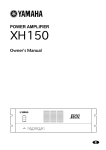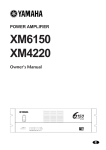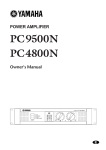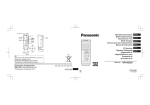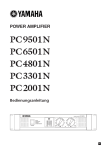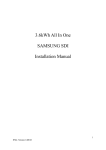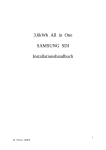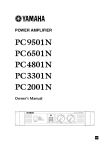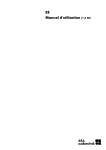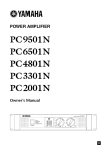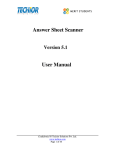Download Yamaha XS250 Owner`s manual
Transcript
POWER AMPLIFIER XS350 XS250 Owner’s Manual 350 POWER POWER AMPLIFIER XS SERIES ON OFF POWER SIGNAL CLIP CH A PROTECTION CLIP SIGNAL CH B E Introduction Thank you for purchasing a Yamaha XS350, XS250 series power amplifier. This series of audio amps was developed from Yamaha's wealth of experience in building PA equipment and its tradition of careful attention to every detail of circuit design. These amps feature high power and superb quality together with superior reliability and stability, guaranteeing the highest possible audio performance. Main features of the XS350, XS250 series • The unit is equipped with two types of inputs: balanced XLR and barrier strip, and two types of outputs: barrier strip and binding post. This combination of inputs and outputs affords flexible capabilities and accommodates a wide range of applications. • Three operating modes are provided: STEREO mode in which CHANNEL A and B operate independently, PARALLEL mode in which a mono source is output by two amp systems, and BRIDGE mode in which the unit operates as a single high-power amplifier. • A high pass/low pass switchable filter is provided for each channel. The high pass filter features a continuous controller that allows you to change cut-off frequencies between 25 Hz and 150 Hz. • A SIGNAL indicator and CLIP indicator is provided for each channel. • The PROTECTION indicator shows the status of protective circuitry such as power-on/off protection, output muting, and the DC detection circuit. • Variable-speed low-noise fan(s) ensures high reliability even under demanding conditions. This owner's manual covers the two models XS350, XS250. In order to take full advantage of your power amp and enjoy long and trouble-free operation, please read this owner's manual carefully before use. WARNING: THIS APPARATUS MUST BE EARTHED IMPORTANT THE WIRES IN THIS MAINS LEAD ARE COLOURED IN ACCORDANCE WITH THE FOLLOWING CODE: GREEN-AND-YELLOW : EARTH BLUE : NEUTRAL BROWN : LIVE As the colours of the wires in the mains lead of this apparatus may not correspond with the coloured markings identifying the terminals in your plug, proceed as follows: The wire which is coloured GREEN and YELLOW must be connected to the terminal in the plug which is marked by the letter E or by the safety earth symbol or coloured GREEN and YELLOW. The wire which is coloured BLUE must be connected to the terminal which is marked with the letter N or coloured BLACK. The wire which is coloured BROWN must be connected to the terminal which is marked with the letter L or coloured RED. * This applies only to products distributed by YAMAHA KEMBLE MUSIC (U.K.) LTD. 2 Precautions • • • • • • • • • Connect this unit’s power cord only to an AC outlet of the type stated in this Owner’s Manual or as marked on the unit. Failure to do so is a fire and electrical shock hazard. Do not allow water to enter this unit or allow the unit to become wet. Fire or electrical shock may result. Do not place heavy objects, including this unit, on top of the power cord. A damaged power cord is a fire and electrical shock hazard. In particular, be careful not to place heavy objects on a power cord covered by a carpet. Do not scratch, bend, twist, pull, or heat the power cord. A damaged power cord is a fire and electrical shock hazard. Do not remove the unit’s cover. You could receive an electrical shock. If you think internal inspection, maintenance, or repair is necessary, contact your dealer. Do not modify the unit. Doing so is a fire and electrical shock hazard. If the power cord is damaged (i.e., cut or a bare wire is exposed), ask your dealer for a replacement. Using the unit with a damaged power cord is a fire and electrical shock hazard. If you notice any abnormality, such as smoke, odor, or noise, or if a foreign object or liquid gets inside the unit, turn it off immediately. Remove the power cord from the AC outlet. Consult your dealer for repair. Using the unit in this condition is a fire and electrical shock hazard. Should this unit be dropped or the cabinet be damaged, turn the power switch off, remove the power plug from the AC outlet, and contact your dealer. If you continue using the unit without heeding this instruction, fire or electrical shock may result. • • • • • • • • • • Hold the power cord plug when disconnecting it from an AC outlet. Never pull the cord. A damaged power cord is a potential fire and electrical shock hazard. Do not touch the power plug with wet hands. Doing so is a potential electrical shock hazard. This unit has ventilation holes at the front, rear and sides to prevent the internal temperature rising too high. Do not block them. Blocked ventilation holes are a fire hazard. Allow enough free space around the unit for normal ventilation. This should be: 10 cm at the sides, 30 cm behind, and 20 cm above. These distances should also be adopted when rackmounting the unit. For normal ventilation during use, remove the rear of the rack or open a ventilation hole. If the airflow is not adequate, the unit will heat up inside and may cause a fire. To mount several of these units in an EIA-compliant rack, refer to the rack mounting instructions on page 11. Use only speaker cables when connecting speakers to amplifier outputs. Using other types of cables is a fire hazard. Do not use this amplifier for any purpose other than driving loudspeakers. XLR-type connectors are wired as follows: pin 1: ground, pin 2: hot (+), and pin 3: cold (–). Using a mobile telephone near this unit may induce noise. If noise occurs, use the telephone away from the unit. Clean the contacts of the phone plug before connecting it to the SPEAKERS jack of this unit. Dirty contacts may generate heat. Contents Controls and Functions ............................................. 4 Front Panel ........................................................... 4 Rear Panel ........................................................... 5 Speaker Impedance ............................................. 7 Caution for Speaker Connection ............................... 9 Rack Mounting ........................................................ 10 Mounting in an EIA standard rack ..................... 10 Portable Rack Mounting .................................... 11 Fixed Installation Mounting ................................ 11 General Specifications ....................................... 12 Specifications .......................................................... 12 Block Diagram .................................................... 13 Dimensions ........................................................ 13 Troubleshooting ...................................................... 14 3 Controls and Functions ■ Front Panel POWER 1 3 2 ON 4 OFF POWER SIGNAL CLIP CH A 1 POWER switch and indicator This is the main POWER switch. Press to power ON the amplifier. Press again to power OFF. The POWER indicator lights up when the amplifier is powered ON. 2 SIGNAL indicators These green LED indicators light up when the respective channel’s output signal exceeds 2 Vrms. This is equivalent to 1/2 W into 8Ω, 1 W into 4Ω. 3 CLIP indicators These red LED indicators light up when the respective channel’s output signal distortion exceeds 1% (i.e. clipping). Output signal clipping is usually due to excessive input signal levels. PROTECTION CLIP SIGNAL CH B 4 PROTECTION indicator These LED indicators light up to indicate that the protection circuit is working. The speaker system is disconnected from the amplifier outputs and no sound is output from the speakers. The protection circuit is activated in the following situations: • When the amplifier is powered on: The protection circuit is activated for approximately 3 seconds when the amplifier is powered on. After 3 seconds, the protection system is deactivated automatically, and the amplifier is ready to use. • If a DC voltage is present at the amplifier’s outputs: If the DC voltage problem is corrected, normal amplifier operation resumes. • If overheating occurs: Turn off the power to the amplifier to cool down the unit and consult the Precautions section of this manual to improve the vent condition, if necessary. Turn the power on to the amplifier after it cools down. 4 ■ Rear Panel 1 2 3 4 FILTER CHANNEL B CHANNEL A FREQ. FREQ. 90 90 50 15 20 50 125 125 Hz 150 25 Hz 150 40 00 –dB 0 00 CHANNEL B LOW CUT SUB WOOFER OFF 10 6 3 25 30 40 25 15 20 10 6 3 25 30 LOW CUT SUB WOOFER OFF –dB 0 CHANNEL A SPEAKERS MODE B-1 BRIDGE STEREO PARALLEL B-2 CHANNEL A-2 – CHANNEL A-1 4-8Ω/CHANNEL (STEREO) + + – 4-8Ω/CHANNEL (STEREO) + + – – INPUT CHANNEL B INPUT CHANNEL A CHANNEL B G CHANNEL A (BRIDGE) (PARALLEL) G (–) (–) (+) (+) 8-16Ω (BRIDGE) 8-16Ω (BRIDGE) (BRIDGE) (PARALLEL) 5 6 1 Frequency controls/Filter select switches (CHANNEL A, B) These knobs and sliding switches are used to select a filter type and control the cut-off frequencies respectively. You can select one of the following filter type: LOW CUT SUB WOOFER OFF 2 Volume controls (CHANNEL A, B) These knobs enable you to adjust the output level of Channels A and B in the range between –∞ dB and 0 dB. In BRIDGE mode, only the volume control for Channel A is available. 3 STEREO/BRIDGE/PARALLEL switch This slide switch is used to set the amplifier operating mode: STEREO, BRIDGE or PARALLEL. BRIDGE STEREO OFF ........................ Turns the filter off. SUB WOOFER ...... Turns the low pass filter on. (The cut-off frequencies for the low pass filter are fixed.) This setting is suitable when using the unit as an amplifier for a subwoofer. LOW CUT .............. Turns the high pass (low cut) filter on. (The cut-off frequencies are variable.) If you select “LOW CUT,” you can use the frequency controls to adjust the cut-off frequencies in the range of 25 Hz to 150 Hz. FREQ. 90 50 125 25 Hz 150 Note: In BRIDGE mode, only the frequency control and filter select switch for Channel A are available. PARALLEL • STEREO mode In this mode, channels A and B operate independently (as a conventional stereo amp). The CHANNEL A input signal will be output from the CHANNEL A output jacks, and the CHANNEL B input signal will be output from the CHANNEL B output jacks. • BRIDGE mode In this mode, the CHANNEL A input signal will be output from the BRIDGE output jacks. In this case, use the rear panel CHANNEL A volume control to adjust the volume. • PARALLEL mode In this mode, the CHANNEL A input signal will be output from the output jacks of both channels A and B. The CHANNEL B input jack is not used. The CHANNEL A and B volumes can be adjusted independently. 5 4 SPEAKERS terminals 6 GND terminals Two types of speaker output terminals: Binding post (Channel A-1, B-1) and barrier strip (Channel A-2, B-2) are available. These parallel wirings are internally connected and output identical signals simultaneously. The output impedance varies depending on whether you use either or both types of SPEAKERS terminals. (Refer to “Speaker Impedance” on page 7 for more information.) The following figures show terminal polarity in STEREO, PARALLEL, and BRIDGE modes. • STEREO, PARALLEL mode SPEAKERS B-1 CHANNEL A-1 4-8Ω/CHANNEL (STEREO) B-2 CHANNEL A-2 4-8Ω/CHANNEL (STEREO) (–) (–) (+) (+) 8-16Ω (BRIDGE) 8-16Ω (BRIDGE) • BRIDGE mode SPEAKERS B-1 CHANNEL A-1 4-8Ω/CHANNEL (STEREO) B-2 CHANNEL A-2 4-8Ω/CHANNEL (STEREO) 8-16Ω (BRIDGE) 8-16Ω (BRIDGE) In BRIDGE mode, the (-) jacks of CHANNELS A1, B-1 and A-2, B-2 are not used. The minimum impedance for the connected speaker system is specified in “Speaker Impedance” on page 7. 5 INPUT terminals (CHANNEL A, B) Two types of balanced terminals for channels A and B are provided. Channel A input terminal is used in BRIDGE and PARALLEL mode. • XLR-3-31 type connector They are wired pin 1–ground, pin 2–hot (+), and pin 3 cold (-). Hot 1 2 Ground 3 Cold • Barrier strip Hot (+), Cold (-) and Ground (G). 6 This is the grounding screw terminal. If hum or noise occurs, ground (earth) the unit via this jack, or try connecting it to the chassis of the mixer or preamp, etc. ■ Speaker Impedance In STEREO and PARALLEL modes, the minimum load (i.e., speaker) impedance is 4Ω. In BRIDGE mode it is 8Ω. Make sure that the impedance does not fall below this specified impedance. Using the barrier strip and binding posts simultanuously STEREO mode connections: MODE SPEAKERS BRIDGE STEREO PARALLEL + – + – + + – – Set to STEREO PARALLEL mode connections: MODE BRIDGE STEREO PARALLEL – + + – – + + – Set to PARALLEL Each speaker min. 8Ω BRIDGE mode connections: MODE SPEAKERS BRIDGE STEREO Each speaker min. 8Ω PARALLEL + – + – + + – – Set to BRIDGE – + Speaker min. 16Ω – + Speaker min. 16Ω 7 Using the barrier strip or terminal posts STEREO mode connections: MODE BRIDGE STEREO PARALLEL Set to STEREO PARALLEL mode connections: MODE BRIDGE STEREO PARALLEL Set to PARALLEL • Using the barrier strip • Using the terminal posts SPEAKERS SPEAKERS + – + – + + – – Not used – + + – – + + + – – Not used + – – + Each speaker min. 4Ω + – Each speaker min. 4Ω BRIDGE mode connections: MODE BRIDGE STEREO PARALLEL Set to BRIDGE • Using the barrier strip • Using the terminal posts SPEAKERS SPEAKERS – + – + + + – + Speaker min. 8Ω 8 + – – Not used – – + + + – – Not used – + Speaker min. 8Ω Caution for Speaker Connection 1. Turn off the POWER switch. 2. Remove the cover attachment screws and remove the protective cover from the speaker terminals. Screw 3. For Barrier strip: After removing approx. 15 mm of insulation from the ends of the speaker cables, bind the bare ends of the speaker wires in the corresponding speaker terminals and tighten the terminals to securely clamp the wires. Refer to page 6 for speaker porality. • Speaker fuse The output capacity of your amplifier is very high: 170 W+170 W (8Ω), 250 W+250 W (4Ω) in stereo and 500 W (8Ω) in monaural on the XS250; 230 W+230 W (8Ω), 350 W+350 W (4Ω) in stereo and 700 W (8Ω) in monaural on the XS350. Be sure to use a speaker system that has sufficient input capacity. If the input capacity of your speaker system is lower than the rated output of the power amplifier, you can protect your speakers by connecting a fuse serially between the speaker and amplifier as shown below. Speaker system Power amplifier _ + + _ 15mm* Fuse Use the following formula to determine the fuse capacity according to the speaker’s input capacity. Po = I R → I = √Po/R 2 * Shown actual size. For Five-way binding post: After removing approx. 15 mm of insulation from the ends of the speaker cables, pass the bare ends of the speaker wires through the holes in the corresponding speaker terminals and tighten the terminals to securely clamp the wires. Refer to page 6 for speaker porality. P0 [W] : Speaker’s continuous input capacity (noise or RMS) R [Ω] : Speaker’s nominal impedance I [A] : Required fuse capacity ex.) Speaker’s continuous input capacity : 100 W Speaker’s impedance : 8Ω I = √100/8 15mm* In this example, the required fuse capacity is calculated as 3.5 [A]. • Speaker cable If you use a long speaker cable, use as thick a cable as possible to prevent deterioration of the damping factor or power loss inside the cable. * Shown actual size. At this time make sure that the bare ends of the speaker cables do not extend from the terminals in such a way that they touch the chassis. Wire should not touch the chassis. Wire should not touch the chassis. 4. Reattach the protective cover over the speaker terminals. 9 Rack Mounting ■ Mounting in an EIA standard rack If multiple high-power amp units are mounted in a rack with poor ventilation, the heat from the amps will cause the interior of the amp to become very hot, causing the performance of the amps to be impaired. In particular, when mounting in a rack whose back can not be left open, mount according to the following instructions. Rack: Leave a gap of 10 cm or more between the rear panel of the rack and the rear panel of the amplifier. Fan: Use a fan with 1.5 m3/min or more maximum wind and 5 mmH2O or more maximum static pressure. Mounting: Install the fan kit on the top slot or the top panel of the rack and install a blanking panel between two amps. XS350/XS250 .5 ø4 4- 71.5±0.1 248 Blanking panel 5 6. x 88 478 76.2 5 C1 78 Fan kit 71.5±0.1 Example of mounting The figure on the left below shows an example of a fan kit (panels and two fans) on the top slot of the rack. The fans are Minebia 3115PS-12T-B30 (with 0.9 m3/min maximum wind and 5 mmH2O maximum static pressure). The figure on the right below is a dimensional diagram of a panel on which two 3115PS-12T-B30 are installed. 11 4- 463 480 XS350/XS250 Blanking panel XS350/XS250 10 Unit: mm ■ Portable Rack Mounting This unit uses a forced cooling system in which air comes in through the front opening and goes out from the sides and rear. If you mount a single unit on a portable rack, be sure to maintain vent openings on the rear and sides. (Side View) (Rear View) Completely open Front FILTER CHANNEL B CHANNEL A LOW CUT LOW CUT 40Hz OFF Air intake Air exhaust OFF 15 20 40Hz 80Hz 80Hz 40 10 6 3 25 30 40 00 HIGH CUT 5kHz 15 20 10 6 3 25 30 –dB 0 00 CHANNEL B HIGH CUT OFF –dB 0 CHANNEL A SPEAKERS OUTPUT VOLTAGE CHANNEL B 5kHz 10kHz OFF 10kHz 70V – INPUT CHANNEL B CHANNEL A CHANNEL A 100V + + – INPUT CHANNEL B + – G + CHANNEL A – G 70V = 32Ω/CHANNEL 100V = 64Ω/CHANNEL ■ Fixed Installation Mounting Do not block the vent openings on the rear and sides when you use the power amplifier. More than 10 cm More than 10 cm More than 10 cm Front Front 11 Specifications ■ General Specifications XS250 Power Output Level (Rated Power) 20 Hz~20 kHz THD+N= 0.1% XS350 8Ω/STEREO 4Ω/STEREO 8Ω/BRIDGE 170 W + 170 W 250 W + 250 W 500 W 230 W + 230 W 350 W + 350 W 700 W 1 kHz THD+N= 0.1% 8Ω/STEREO 4Ω/STEREO 8Ω/BRIDGE 185 W + 185 W 280 W + 280 W 560 W 250 W + 250 W 400 W + 400 W 800 W 1 kHz, 20 ms, no clip 600 W + 600 W 2Ω/STEREO 400 W + 400 W Power Bandwidth Half Power 10 Hz~40 kHz (THD+N= 0.1%) Total Harmonic Distortion (THD + N) 20 Hz~20 kHz, Half Power 4~8Ω/STEREO 8Ω/BRIDGE 0.05% Frequency Response 8Ω, Po= 1 W +0.5, –1 dB Intermodulation distortion (IMD) 60 Hz:7 kHz, 4:1, Half Power 4~8Ω/STEREO 8Ω/BRIDGE 0.05% Channel Separation Half Power, RL= 8Ω, Vol. max., input 600Ω shunt ≥65 dB, 20 Hz~20 kHz 12.7 kHz LPF IHF-A network ≤ –70 dB ≤ –75 dB Damping Factor 8Ω, f= 1 kHz ≥100 Slew Rate 8Ω full swing STEREO BRIDGE ±30 V/µs ±40 V/µs Residual Noise Vol. min. SN Ratio 10 Hz~50 kHz 100 dB Sensitivity (Vol. max.) Rated Power into 8Ω +1.7 dB +3.1 dB Voltage Gain (Vol. max.) 32.1 dB 32.1 dB Input Impedance 30 kΩ/Balanced, 15 kΩ/Unbalanced Controls Front Panel Rear Panel POWER switch (ON/OFF) Volume (31 position)x 2 Mode switch (STEREO/BRIDGE/PARALLEL) Filter switch (OFF/SUBWOOFER/LOW CUT)x 2 (–12 dB/oct.) Freq. control (25 Hz~125 Hz)x 2 Connectors Input Barrier strip terminal XLR-3-31 type/ch Barrier strip terminal 5-way binding posts Output Indicators POWER PROTECTION CLIP SIGNAL Green x 2 (Red) x 2 (Red) x 2 (Green) Protection Circuits POWER switch ON muting, DC detection, Temp. detection (heatsink temp ≥ 90°C) PC limiter RL ≤ 1Ω Fan Speed Power Requirements Low/~50°C, Variable/50~70°C, High/70°C~ US & Canada Europe Other Power Consumption Idling 1/8 output power, 4Ω Maximum output, 4Ω 120 V, 60 Hz 230 V, 50 Hz 240 V, 50 Hz 450 W/600 VA 45 W 400 W 1000 W Dimensions (W x H x D) 480 x 132 x 319 mm Weight 18 kg 0 dB=0.775 Vrms, Half Power=1/2 Power Output Level (Rated Power) Specifications subject to change without notice. 12 600 W/800 VA 45 W 550 W 1400 W 20 kg ■ Block Diagram HPF CHANNEL A (BRIDGE) (PARALLEL) CLIP FREQ INPUT CHANNEL A (BRIDGE) (PARALLEL) SIGNAL – A-1 BA LPF CHANNEL A + + – + PROTECTION + – LOW CUT SUB WOOFER OFF – G Protector INV INPUT CHANNEL B-1 SPEAKERS + HPF – G INPUT CHANNEL B – FREQ CHANNEL B A-2 LPF + + – + CHANNEL B-2 BA CHANNEL B LOW CUT SUB WOOFER OFF PARALLEL BRIDGE STEREO – CLIP SIGNAL MODE D:319 ■ Dimensions H:132 W:480 Unit: mm 13 Troubleshooting The following table lists the main causes of abnormal operation and the corrective measures required, as well as the protective circuit operation in each case. Indicator Probable Cause Remedy There is a short at a speaker terminal, amplifier terminal, or wire. Locate and correst the cause of the short. The amplifier load is excessive. Use a speaker system with an impedance of at least 4Ω (stereo) or 8Ω (bridge). The heat sink temperature has exceeded 90°C. Check the amplifier ventilation conditions and take appropriate measures to improve airflow around the amplifier. The thermal protection circuit operates to protect the power transistors. A DC voltage of ±2 V or greater was generated in the power amplifier’s output circuit. Consult your dealer or nearest Yamaha service center. The relay operates to protect the speaker system. CLIP indicator lights. PROTECTION indicator lights. 14 Protection Circuit The PC limiter circuit operates to protect the power transistors. YAMAHA CORPORATION V352950 R1 1 IP 16 NP Printed in Taiwan Pro Audio Division, #18/3 P.O. Box 3, Hamamatsu, 430-8651, Japan















